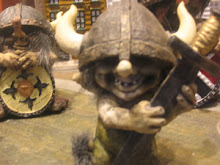Oh no! Not more cubes!
"What? More cubes?" I hear you say. Yes, though I'm behind the times in telling you this, further advancements have been made in developing larger Rubik's Cubes than just The Professor. When I last wrote about the Professor, I was aware that working models of the 6x6x6 and 7x7x7 cubes had already been demonstrated, they were only waiting for the manufacturing process. The developer of this style of cube has said that methods to produce cubes up to 11x11x11 currently exist, they merely have to bring them to market. The general assumption is given that this method could actually be extended further, but I don't think I'll be paying for a 13x13x13 any time soon, as the price points for the 6x6x6 and 7x7x7 cubes are between US$46 and US$55.
So what? I couldn't even solve the original!
Don't worry, all is not lost - there are solution pages for these new cubes already, provided by the company, as well as other pages by www.bigcubes.com; other solution pages already exist for even the little 2x2x2 version, though if you know how to solve the corners of any cube, you already know how to solve the little cube. All is not lost. However, in solving the big 7x7x7 cube, there's one important difference between it and the 3x3x3 and Professor. The centres can move in relation to each other, meaning you have to make sure you put the centres into the correct orientation first, as shown by the eight corner cubies.
Why's the big one curved?
That's right, it's not quite a cube any more, as the picture in the Wikipedia article shows. Because of the size of the respective pieces, and indirectly the method of manufacturing, when a face is turned around 45 degrees, the possibility exists that a piece will simply fall out, as it is no longer securely held by adjacent pieces. The curve combats this effect, by overlapping the area occupied by the piece, and will probably be a "feature" of all the larger models. Even the 6x6x6 cube has been modified somewhat so that pieces don't fall out - the summary is that the corner rows are actually 2mm wider than the inner four rows, allowing things to actually work.
Mirror mirror
Of course, other twists exist on the cube, many of them playing on other aspects. This cube differs from others in that all faces have a mirror-like finish of a shiny reflective sticker on each cubie; in addition, each cubie is a unique size instead of the same size as their opposite face equivalents. This makes the cube look really weird when it's mixed up. Hey, at least you'll puzzle the heck out of everyone else when they try it out.
